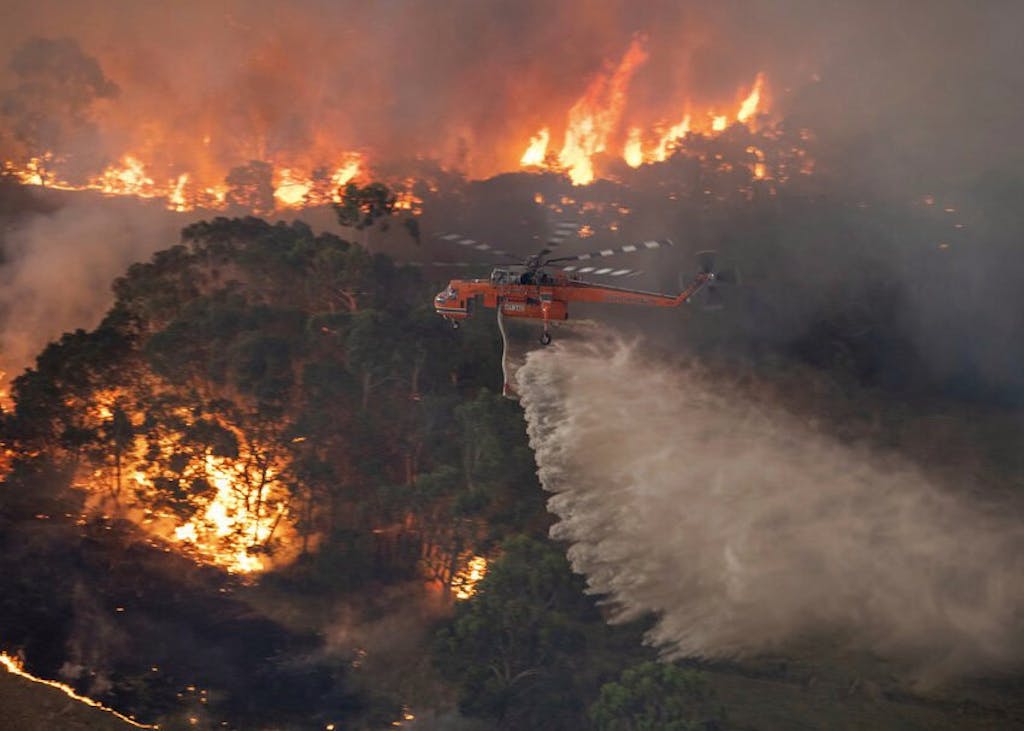What do a winemaker, a dairy producer, and an insurance company all have in common? No, this isn’t the beginning of a bad joke, but the unfolding of a tragic reality.
Australian Vintage, Bega Cheese, and Insurance Australia Group Ltd are just three of an estimated 100,000 businesses that have been impacted by the bushfires in Australia — and they give us a warning for what’s to come.
A potent mix of dry and hot conditions have led to unprecedented bushfires that have claimed dozens of lives, destroyed over 2,000 homes, potentially killed around 1 billion animals, and will pummel the country’s economy. Insurance Australia Group Ltd has already incurred net claim costs of nearly AUD 400 million (around US$270m), which is larger than the GDP of some small island nations.
This is the world at just 1.1°C warming. Hot and dry areas, like Australia, are getting hotter and drier, as projected by scientific reports from the Intergovernmental Panel on Climate Change (IPCC). But we’re on track for much worse: More than 3°C of warming by the end of the century, leading to mass extinctions and large parts of the planet becoming uninhabitable, unless we change course radically and rapidly. In her speech at this year’s World Economic Forum meeting in Davos, Switzerland, Greta Thunberg reminded global political and business leaders why we MUST keep global temperature rise below 1.5°C: “At one degree people are dying because of climate change,” she said. “Every fraction of a degree matters.”

National governments have a critical opportunity to respond to the climate crisis this year by increasing their climate targets under the Paris Agreement in line with the science. At the same time, businesses must confront the vital role they play in driving — or impeding — progress and the conditions for transformational change through their own actions.
Here are four big ways businesses must take climate action in 2020:
1. Treat climate change as a real risk.
For the first time in its 10-year outlook, the World Economic Forum’s Global Risk Report found that the top five global risks to wellbeing and prosperity are all environmental. These include the risk of more extreme weather events, which cause major damage to property, infrastructure, and loss of human life. “There is mounting pressure on companies from investors, regulators, customers, and employees to demonstrate their resilience to rising climate volatility,” said John Drzik, the chairman of Marsh & McLennan insights, one of the report authors. Companies can’t afford to ignore the science, which shows that climate change is causing weather events to become more unpredictable. A recent study found that a group of the world’s biggest companies have valued the climate risks to their businesses at almost $1 trillion — with many impacts like flooding, extreme heat, drought, and more, likely to hit within the next five years. Business leaders need to build in that risk across their plans now, so that their companies, employees — and the communities that rely on them — can stay strong and resilient. For example, Danone, a global food company, whose operations are dependent on water, warns of water scarcity risks influenced by climate change, and the company is taking steps to reduce water consumption across operations.
2. Invest in a carbon neutral future.
To limit global warming to 1.5°C, a target that averts the worst climate impacts according to the IPCC, we must halve emissions by 2030 and be carbon neutral by 2050 (meaning that we are releasing no more emissions than we are absorbing). This is the challenge that both policymakers and business leaders must meet through coordinated action on the Paris Climate Agreement.
Here’s the catch to making it possible: A central part of achieving carbon neutrality by 2050 is transforming our energy systems to run on cleaner sources like solar and wind energy. However, investments in renewables is far below where it needs to be. According to the IPCC, annual investment of $2.4 trillion is needed in the energy sector alone until 2035 to meet our climate goals, but global investment in renewable energy reached just $288 billion in 2018. That’s eight times lower than where we need to be, and — worryingly — far lower than the $933 billion invested in oil, gas, and coal supply in 2018.
Investment in clean energy has a long way to go, but there are promising signs:
- More and more big companies are committing to carbon neutrality and some are going even further. Microsoft recently announced it will be carbon-negative by 2030, meaning it’ll be removing more carbon than it emits by that time.
- In December 2019, four more investors joined the Net-Zero Asset-Owner Alliance, an initiative launched at the 2019 UN Climate Action Summit aimed at getting investors to move to carbon-neutral portfolios. The group’s total assets under management are now at $4 trillion.
- In his widely read annual letter, BlackRock CEO Larry Fink, who runs the largest asset management company, with $7 trillion in assets, singled out climate change as the defining factor in investment. “Climate risk is investment risk,” he warned CEOs. “…we believe that sustainable investing is the strongest foundation for client portfolios going forward.”
- Activists are increasingly pressuring businesses and investors to divest from fossil fuels (see this op-ed from youth climate activists ahead of the 2020 World Economic Forum).
The clean energy shift is a double-win for the planet and for business, but it will require efforts to shift capital now. As the new UN Special Envoy for Climate Action and Finance, Mark Carney, urged leaders in a recent interview, “A question for every company, every financial institution, every asset manager, pension fund or insurer: what’s your plan?” The year 2020 needs to be the one in which business leaders answer that question for carbon neutrality.
3. Nurture nature.
While countries and businesses shift plans to align with the Paris Agreement, we can’t leave nature behind in the process. Our planet is facing another global crisis intertwined with the climate crisis: biodiversity loss. An estimated 1 million plants and animals are threatened by extinction.
Last year, one of the most biodiverse ecosystems on Earth, the Amazon, made headlines when swaths of it went up in flames — a disaster caused by human activity likely linked to deforestation. Scientists, such as the UN Foundation’s Senior Fellow Dr. Thomas Lovejoy, warn that the Amazon is closer to a tipping point where it’ll reach an irreversible cycle of collapse known as a dieback and release massive amounts of carbon.
What can business do to avert this calamity? Agriculture is the largest contributor to biodiversity loss, and it also drives about one-quarter of global emissions. Food and agriculture companies have an obligation to manage land and supply chains with biodiversity in mind. One step businesses can take: joining the One Planet Business for Biodiversity, a coalition of 19 food and agribusiness companies focused on eliminating deforestation, preserving biodiversity, restoring natural ecosystems, and encouraging regenerative agriculture. For example, Nestlé, the world’s largest food and beverage company, committed to ending deforestation in their supply chains this year and will use satellites to monitor changes to forest cover.
4. Prepare to be held accountable.
This year’s Edelman Trust Barometer found that 74% of people around the world want CEOs to take the lead on change instead of waiting for governments. Further, 73% think it’s important for CEOs to speak out about climate change in particular. With public trust on their side, business leaders have an incredible opportunity to take meaningful action and close crucial financing gaps. The world needs more climate champions in the private sector to make the case that acting on the climate crisis makes good business sense, especially in such times of political divisiveness. And they need to actually do it and not just talk the talk. Like Thunberg said at COP25 in Madrid, “The real danger is when politicians and CEOs are making it look like real action is happening when in fact almost nothing is being done apart from clever accounting and creative PR.”
There are many other ways businesses must lead change on climate action and the SDGs this year — and for the next 10 years, as we embark upon the final Decade of Action to deliver the SDGs. Initiatives like the World Benchmarking Alliance, which develops guidelines for companies to measure their own actions, and just launched a list of the 2000 companies with the greatest influence on global SDG progress, can help with tracking and accountability. We know what’s at stake: Inaction on climate change will, among so many things, undo hard-earned progress on global health, poverty, life on land, life below water, and far more — while sustainable economic growth will deliver progress across the board. As UN Secretary-General António Guterres said at COP25 in December, “We are a very long way behind, but there is still reason to believe we can win this race. The next 12 months will be crucial.”
Most immediately, leaders in the private sector will have opportunities to accelerate action at the upcoming Investor Summit on Climate Risk in March, co-hosted by the UN Foundation, Ceres, and the UN Office for Partnerships. The summit, taking place for the ninth time, will mobilize investors and other private sector leaders to drive the transition away from high-emitting investments and toward a net-zero emissions world. And of course, this November at COP26, government leaders will have the opportunity to raise national ambition in line with the science.
It’s on all of us too, to keep using our voices, our votes, and our actions to push businesses and governments to do more. Ultimately, to make the world better, we all need to invest in a better world.



 View All Blog Posts
View All Blog Posts

